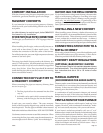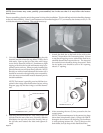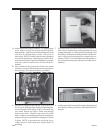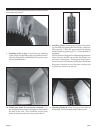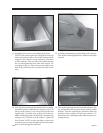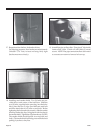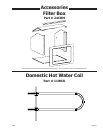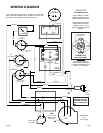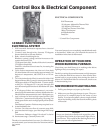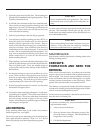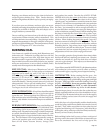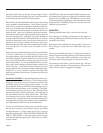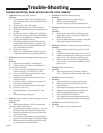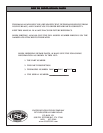
USSC Page 25
ASHES
Ashes never should be allowed to accumulate in the ash
pit so that they in any way impede the flow of combustion
air to the fire. Excess ash accumulation can cause the fire
to go out and also can cause severe damage to the grates
because of the absence of a cooling flow of air beneath
them.
Ashes always should be emptied into a metal container.
Coals can remain hot many hours after a fire is out. Coal
ashes should not be put on gardens as they do not contain
beneficial minerals like wood ashes, and may cause ground
water pollution.
Coal produces considerably more ash than wood, so the
intervals between emptying are much shorter. For equal
heat output, coal will produce seven (7) to ten (10) times
more ash than wood.
CLINKERS
Clinkers can occur in any coal furnace during the process
of burning. These are hard pieces of fused ash that form
in the firebox. They can become hard and large in size
and, therefore, cannot be shaken through the grates in a
coal stove. When there is an appreciable accumulation,
the fire will go out because insufficient air is allowed to
pass through the clinkers to the burning coal.
Once large clinkers have formed, they can be removed
only from above the grates. This usually means the fire
must be allowed to go out before they can be removed.
Clinkers formation can occur from a number of different
causes or a combination of causes. Some of these are:
• Poor quality coal-excess ash content and/or too low a
heat of fusion.
• Too hot a fire (too much draft).
• Too shallow a bed of coals.
• Too deep a bed of coals.
• Excessive Shaking.
• Poking the fire from the top.
• Too little air (draft) after a long, hot fire (caused by
rapid adjustment of draft from a very high setting to a low
setting).
If clinkers do form, the coal quality should be checked
first, and then all the above points should be reviewed
and corrected.
SAFETY
Whenever a loading door is opened, the bypass damper
should be opened first (use a glove to protect you hand),
and the door should be cracked slightly (for about ten (10)
seconds) to allow oxygen to enter and burn any combus-
tible gases that are present before fully opening. Failure
to do this could result in sudden ignition of the unburned
gases when the door is opened.
With the exception of the start-up period, the ash pit door
should never be left open. Serious damage to the stove
can occur from overheating. In extreme cases, this over-
heating could be the cause of an "unfriendly fire".
Coal furnaces are subject to the same installation clear-
ance standards as wood furnaces. Never burn coal in any
furnace that does not have an airtight, unified chimney
system.
Coal furnaces should not be installed in any chimney that
has had a history of back-drafting or flow reversal. Also,
coal furnaces should not be installed in any chimney hav-
ing an excessively large flue. These conditions can cause
improper draft, resulting in carbon monoxide entering the
house rather than being drawn up the chimney. Remem-
ber, coal gases are toxic.
Sulfur dioxide, sulfur trioxide and other ions released from
coal burning may corrode stainless and masonry chim-
neys, and even terra cotta chimney liners and brick in
nearby buildings. Coal with high sulfur content will de-
stroy chimneys especially fast if soot sits in the flue for
extended lengths of time. It is important to clean chim-
neys regularly.



